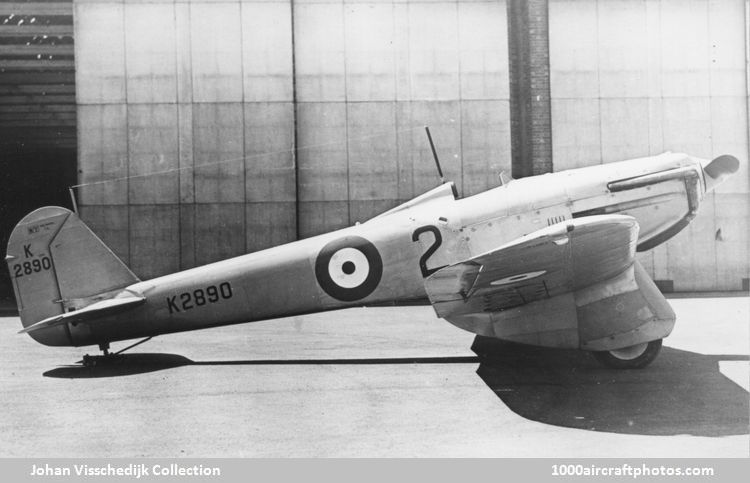The Supermarine answer to specification F.7/30 introduced many novel features. It had an all-metal structure, and thick gull wing and short cantilever landing gear, and the design incorporated one of the first attempts to reduce weight of coolant and radiators for liquid-cooled engines. A preference had been expressed by the Air Staff for the Rolls-Royce Kestrel IV engine with evaporative cooling, saving much weight of water. A further saving was made in drag by using the leading edges of the wing as condensers.
Other features which Supermarine embodied in their F.7/30 were the air-brake (a panel swung out from the underside of the fuselage) and small fillets between the wing and fuselage. The armament was four 0.303 in (7.7 mm) machine guns, two mounted conventionally in the front fuselage and two in the landing gear fairings inboard. No attempt was made to retract the wheels of the landing gear, despite Supermarine's long experience with retractable landing gears on their amphibians. The first proposals to F.7/30 were submitted by Supermarine on February 20, 1932.
Some twenty months elapsed between the official 'Instructions to Proceed' with the Type 224 and its first flight by 'Mutt' Summers on 19 February, 1934. Power plant was a derivative of the Kestrel, the 600 hp Rolls-Royce Goshawk II twelve-cylinder steam-cooled V-engine. Most of the test flying of the Spitfire, as the type was named by Supermarine, was done by Summers, with H. W. R. Banting of Vickers, Weybridge, Major H. J. Payn, and George Pickering, Supermarine's own test pilot, assisting at times.
Its performance was disappointing, the top speed recorded being 228 mph (367 kmh), some 17 mph (27 kmh) below estimates, while the climb to 15,000 ft (4,572 m) was 9 min 30 sec, considerably exceeding the estimate of 6 min 36 sec. However, none of the entries for the F.7/30 competition, Blackburn F.3, Bristol 123, Bristol 133, Gloster Gladiator, Gloster SS.19, Hawker P.V.3, Supermarine 224, and Westland F.7/30, succeeded in official trials at Martlesham.
Supermarine suggested a number of modifications but by the end of 1934 little progress had been made, the Gloster Gladiator was selected, and further development of the 224 was halted. George Pickering flew it to the RAE at Farnborough on July 24, 1935, where it became popular as the officers' 'hack', being in fact a very good flying machine. On May 25, 1937, it went to AAEE, Martlesham Heath, and eventually to Orfordness where the life of the sole Type 224 Spitfire ended as a gunnery target. The name Spitfire was reused for the famous WW II fighter aircraft, also built by Supermarine."
Span: 45 ft 10 in (13.97 m)
Length: 29 ft 5.25 in (8.97 m)
Height: 11 ft 11 in (3.63 m)
Wing area: 295 sq.ft (27.41 sq.m)
Weight empty: 3,422 lb (1,552 kg)
Loaded weight: 4,743 lb (2,151 kg)
Max speed: 228 mph (367 kmh) at 15,000 ft (4,572 m)
Landing speed: 60 mph (96.6 kmh)
Climb: to 15,000 ft (4,572 m) 6 min
Service ceiling: 38,800 ft (11,826 m)
